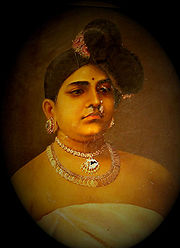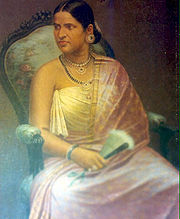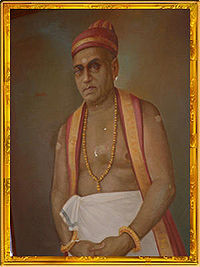
Thampi
Encyclopedia

Travancore
Kingdom of Travancore was a former Hindu feudal kingdom and Indian Princely State with its capital at Padmanabhapuram or Trivandrum ruled by the Travancore Royal Family. The Kingdom of Travancore comprised most of modern day southern Kerala, Kanyakumari district, and the southernmost parts of...
and their morganatic wives belonging to Illathu Nair
Illathu Nair
Illathu Nair is one of the subcastes of the Nair community among Keralites. They are mostly found in the Travancore and Cochin areas. Illathu Nairs were considered highest in the Nair hierarchy in Travancore. Purification rites by the Maarans and priestly service from the Elayatus distinguished the...
or other similar Kshatriya
Kshatriya
*For the Bollywood film of the same name see Kshatriya Kshatriya or Kashtriya, meaning warrior, is one of the four varnas in Hinduism...
castes. They form a part of the Nair
Nair
Nair , also known as Nayar , refers to "not a unitary group but a named category of castes", which historically embody several castes and many subdivisions, not all of whom bore the Nair title. These people historically live in the present-day Indian state of Kerala...
caste (even if the mother is a Rajput
Rajput
A Rajput is a member of one of the patrilineal clans of western, central, northern India and in some parts of Pakistan. Rajputs are descendants of one of the major ruling warrior classes in the Indian subcontinent, particularly North India...
or some other non-Nair, as in the case of the Kunju Thampies) and had no title of succession to the throne.
Origin
Since the Maharajahs of South KeralaKerala
or Keralam is an Indian state located on the Malabar coast of south-west India. It was created on 1 November 1956 by the States Reorganisation Act by combining various Malayalam speaking regions....
(Travancore
Travancore
Kingdom of Travancore was a former Hindu feudal kingdom and Indian Princely State with its capital at Padmanabhapuram or Trivandrum ruled by the Travancore Royal Family. The Kingdom of Travancore comprised most of modern day southern Kerala, Kanyakumari district, and the southernmost parts of...
) also belong to the warrior race of the Nairs, they followed the matrilineal system (Marumakkathayam
Marumakkathayam
Marumakkathayam is a matrilinear system of inheritance which was followed by all Nair castes including of Royal Families, some of the Ambalavasis, Arayars, Ezhava, some tribal groups and Mappilas in North Malabar of Kerala state, South India. Unlike other Brahmin families, Payanoor Nambootiris...
) of inheritance. Hence when a king died his sister's son would become the next Varma (Samanthan Nair) ruler and his own son born of his wife, usually of the Illathu Nair
Illathu Nair
Illathu Nair is one of the subcastes of the Nair community among Keralites. They are mostly found in the Travancore and Cochin areas. Illathu Nairs were considered highest in the Nair hierarchy in Travancore. Purification rites by the Maarans and priestly service from the Elayatus distinguished the...
caste would be called Thampi with the title "Kannaku Chempakaraman" which was also one of the highest titles of nobility
Nobility
Nobility is a social class which possesses more acknowledged privileges or eminence than members of most other classes in a society, membership therein typically being hereditary. The privileges associated with nobility may constitute substantial advantages over or relative to non-nobles, or may be...
in Travancore.

Marumakkathayam
Marumakkathayam is a matrilinear system of inheritance which was followed by all Nair castes including of Royal Families, some of the Ambalavasis, Arayars, Ezhava, some tribal groups and Mappilas in North Malabar of Kerala state, South India. Unlike other Brahmin families, Payanoor Nambootiris...
law of matrilineal inheritance existed in Travancore, the sons of these Thampi gentlemen would, however, not gain any distinguishing title.
Families from where Maharajas got married are known as "Ammaveedu
Ammaveedu
Ammaveedus were the residences of the consorts of the Maharajahs of Travancore in Trivandrum. The descendants of the Maharajahs were considered as members of these Ammaveedus, with a status next only to royalty...
s". Arumana Ammaveedu
Ammaveedu
Ammaveedus were the residences of the consorts of the Maharajahs of Travancore in Trivandrum. The descendants of the Maharajahs were considered as members of these Ammaveedus, with a status next only to royalty...
, Vadasseri Ammaveedu, Nagercoil Ammaveedu, Thiruvattar Ammaveedu, etc. are some of the prominent families in Trivandrum from where the Maharajas of Travancore married. The Rajahs of Travancore traditionally took wives from Ammaveedus and such Royal consorts, known as Ammachis would get the additional title of Panapillai Amma
Panapillai Amma
Panapillai Amma was the title held by the consort of the ruling Maharajah of Travancore. Its literal translation is 'the royal consort' since as per the formerly existent matriarchal system in Travancore, the Maharajah's sister, and not his wife, was the Maharani. Thus the wife took the title of...
. If at all another lady from outside the Ammaveedu's was to be married to the Rajah, she would be adopted to one of the Ammaveedu
Ammaveedu
Ammaveedus were the residences of the consorts of the Maharajahs of Travancore in Trivandrum. The descendants of the Maharajahs were considered as members of these Ammaveedus, with a status next only to royalty...
s first and then wed to the King. This was the case in the marriage of Maharajah Swathi Thirunal, Maharajah Ayilyam Thirunal
Ayilyam Thirunal
Maharajah Ayilyam Thirunal Rama Varma was the ruler of the princely state of Travancore in India from 1860 to 1880. His reign was highly successful with Travancore gaining the appellation of "model state of India"...
and Maharajah Moolam Thirunal.
Position
As mentioned previously, the title of Thampi was also given to some loyal noble families in Travancore. Thampis had special privileges in Travancore. Besides the Maharajah, they were the only people permitted the use of Palanquins. They also had the right to visit their cousin, their father's heir as per the MarumakkathayamMarumakkathayam
Marumakkathayam is a matrilinear system of inheritance which was followed by all Nair castes including of Royal Families, some of the Ambalavasis, Arayars, Ezhava, some tribal groups and Mappilas in North Malabar of Kerala state, South India. Unlike other Brahmin families, Payanoor Nambootiris...
law, without formally previously announcing their visit. The very term Thampi and Thankachi meant, in Tamil language
Tamil language
Tamil is a Dravidian language spoken predominantly by Tamil people of the Indian subcontinent. It has official status in the Indian state of Tamil Nadu and in the Indian union territory of Pondicherry. Tamil is also an official language of Sri Lanka and Singapore...
, brother and sister respectively which indicated the position of the Thampi families as relatives of the Royal House of Travancore.
Tradition
The consort of the ruling prince was known as the Ammachi with the title of Panapillai AmmaPanapillai Amma
Panapillai Amma was the title held by the consort of the ruling Maharajah of Travancore. Its literal translation is 'the royal consort' since as per the formerly existent matriarchal system in Travancore, the Maharajah's sister, and not his wife, was the Maharani. Thus the wife took the title of...
. To the names of the sons of the Maharajahs was prefixed the title of Sri
Sri
Sri , also transliterated as Shri or Shree or shre is a word of Sanskrit origin, used in the Indian subcontinent as polite form of address equivalent to the English "Mr." in written and spoken language, or as a title of veneration for deities .-Etymology:Sri has the root meaning of radiance, or...
suffixed with Thampi. The daughters were known as Ponnammas. The other members of the Ammaveedu
Ammaveedu
Ammaveedus were the residences of the consorts of the Maharajahs of Travancore in Trivandrum. The descendants of the Maharajahs were considered as members of these Ammaveedus, with a status next only to royalty...
s however were simply known as Thampis and Thankachis or Kochammas.
The Thampi Insurrection

Rajput
A Rajput is a member of one of the patrilineal clans of western, central, northern India and in some parts of Pakistan. Rajputs are descendants of one of the major ruling warrior classes in the Indian subcontinent, particularly North India...
, Princess Abhirami of the Kosala Royal House (present day Ayodhya). He had two sons (Sri Padmanabhan Thampi and Sri Raman Thampi) and one daughter. The princess held the Royal title of Vempadi Valiammachi.
Princess Abhirami had problems in her horoscope and therefore the Royal astrologers of Ayodhya sent her on a pilgrimage for 14 years to various holy places. A number of her relatives and bodyguards accompanied her during her journey. Rama Varma met her in Suchindram and married her. He promised the Royal family of Kosala that Abhirami's children would succeed the throne, although as per the Travancore customs, it was Prince Marthanda Varma (Rama Varma's nephew), who held the right to succeed him. Immediately after Rama Varma's death, the war of succession broke out and Marthanda Varma was crowned as the Maharajah of Travancore.
The Kunju Thampis wanted to succeed to the throne of their father which was promised to their mother and Rajput
Rajput
A Rajput is a member of one of the patrilineal clans of western, central, northern India and in some parts of Pakistan. Rajputs are descendants of one of the major ruling warrior classes in the Indian subcontinent, particularly North India...
royal house of Ayodhya. With this view, they organised a revolt for getting justice from the King's promise with the help of army chief Azhagappa Mudaliar availed from Madurai King and later from 'Ettuveetil Pillamar'.
The Kunju Thampis for some time remained low. But their instigators, the Ettuveetil Pillamar
Ettuveetil Pillamar
The Ettuveetil Pillamar were a group of nobles from eight Nair Houses in erstwhile Venad in present day Kerala state, South India. They were associated with the Padmanabhaswamy temple in Thiruvananthapuram and the Ettara Yogam. They were known by the villages in which they resided and all of them...
against whom the Maharajah had secured documented evidence of conspiracy to assassinate him and instigating the Kunju Thampis to seek Pandyan help, came to their heed once again. On the morning of 28 October 1730, Padmanabhan and Raman Thampi called on Maharajah Marthanda Varma
Marthanda Varma
Marthanda Varma , was the founder of the Indian Hindu feudal kingdom of Travancore from Venad SwaroopamHe ruled from 1729 till his death in 1758, having succeeded his maternal uncle Dharma Raja.King Marthanda Varma is usually credited as the "founder of Kingdom of Travancore" from...
who was then at Nagercoil Palace. The sentries at the door had been particularly informed not to permit the Kunju Thampis entry into his chamber, where he was sleeping on a swinging cot.
Raman Thampi, who after seeing the possible defeat at the hands of King Marthanda Varma, headed towards Kalkulam to kill the former. But he was stopped by Ramayyan, who killed Raman Thampi in a fierce encounter that followed.Hearing about his younger brother's death, Pappu Thampi rushed into the Maharajah's chamber and tried to attack him. He missed his aim and his sword struck the low ceiling of the room giving enough time to Marthanda Varma
Marthanda Varma
Marthanda Varma , was the founder of the Indian Hindu feudal kingdom of Travancore from Venad SwaroopamHe ruled from 1729 till his death in 1758, having succeeded his maternal uncle Dharma Raja.King Marthanda Varma is usually credited as the "founder of Kingdom of Travancore" from...
to recover from the shock, who eventually disarmed Pappu Thampi and later killed the elder Thampi with his mighty sword.
Thampies are also called "Thoruvam", a corrupted form of Swaroopam, in Trivandrum as they had Royal origins. There is a poem in praise of these Thampies of Nagercoil who fought against Vara Vanchi Veera Marthanda Varma, called "Thampimar kadai" which is very popular in South Western Tamil Nadu.
The Rajput relatives and attendants of Princess Abhirami settled down near Nagarcoil. After the revolt by the Kunju Thampis, the surviving Rajputs were removed from Nagarcoil and brought to Trivandrum. Many of them were recruited in to the Travancore Armed Forces
Nair Brigade
The Nair Brigade was the army of the erstwhile kingdom of Travancore in India. Nairs were a warrior community in the region which was responsible for the security of Travancore and other local kingdoms. King Marthanda Varma's personal bodyguard was called 'Thiruvithamkoor Nair Pattalam'...
, mainly in cavalry division. Although their population was quite significant during the 18th century, it declined afterward, as many were assimilated in to the Royal Nair clans. A relative of Princess Abhirami - Krishna Singh, a full blooded Rajput in his seventies is among the few remaining Rajputs residing in Trivandrum currently.
See also
- UnnithanUnnithanUnnithan is the modern form of the older title of Thankal . Unnithans were among the highest of the Nair aristocracy in the Travancore region of the Indian state of Kerala. Unnithan ladies of the Edassery Pattaveettil family were often married by the Rajahs or princes of the royal families such...
- ValiathanValiathanValiathan is the surname used by members of certain families that are all part of a single original Tharavad and was a title corresponding to Unnithan. This latter title, originally known as Thankal, was conferred by the Rajah of Kayamkulam on Nair nobles of his state...
- Irayimman ThampiIrayimman ThampiRavi Varman Thampi better known as Irayimman Thampi was a Carnatic musician as well as a music composer from Kerala, India. He was a vocalist in the court of Swathi Thirunal...
- Nair Subcastes

